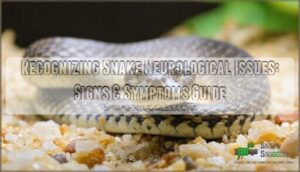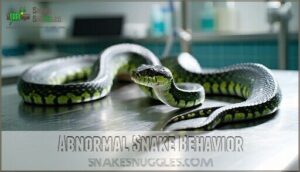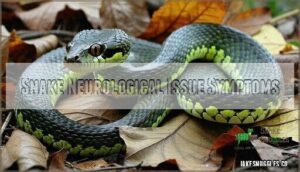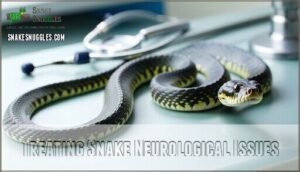This site is supported by our readers. We may earn a commission, at no cost to you, if you purchase through links.

You’ll notice decreased appetite, reduced activity, or unusual head positioning as early warning signs.
The telltale "stargazing" behavior—where your snake twists its head upward unnaturally—signals central nervous system problems.
Look for disorientation, loss of coordination, tremors, or difficulty moving in straight lines.
Advanced symptoms include paralysis, convulsions, and inability to right themselves when flipped over.
These issues stem from viral infections, parasites, environmental stress, or genetic conditions.
Quick recognition matters because early intervention can prevent permanent neurological damage and give your snake the best chance at recovery.
It is crucial to identify these signs to ensure your pet receives timely care for the best possible outcome, focusing on preventing permanent damage and promoting a successful treatment with a good prognosis.
Table Of Contents
- Key Takeaways
- Snake Neurological Disorders
- Recognizing Snake Behavior
- Snake Nervous System
- Snake Neurological Issue Symptoms
- Treating Snake Neurological Issues
- Frequently Asked Questions (FAQs)
- How do you know if your snake has a neurological disorder?
- How to know if a snake is nervous?
- What is stargazing syndrome in snakes?
- Can neurological problems be passed genetically?
- How quickly do neurological symptoms develop?
- Are certain snake species more vulnerable?
- Can stress trigger neurological issues in snakes?
- Is full recovery possible from neurological damage?
- Conclusion
Key Takeaways
- Watch for stargazing behavior – You’ll notice your snake unnaturally twisting its head upward and staring at the ceiling, which signals serious central nervous system problems that need immediate attention.
- Monitor coordination and movement changes – Look for tremors, difficulty moving in straight lines, loss of balance, or your snake’s inability to right itself when flipped over, as these indicate neurological dysfunction.
- Don’t ignore appetite and activity shifts – You should be concerned if your snake shows decreased appetite, reduced activity, unusual head positioning, or disorientation, since these are often early warning signs.
- Act quickly when symptoms appear – Early intervention prevents permanent neurological damage, so you need to contact a reptile veterinarian immediately when you spot any neurological symptoms for the best chance at recovery.
Snake Neurological Disorders
Recognizing neurological disorders in snakes requires careful observation of both physical and behavioral changes that deviate from normal patterns.
You’ll need to watch for specific symptoms like abnormal posturing, coordination problems, or unusual movement patterns that signal potential nervous system dysfunction, including issues with coordination problems.
Signs of Neurological Issues
Something’s not quite right when your snake starts displaying unusual neurological symptoms that signal potential nervous system problems.
These snake neurological diseases can manifest through various physical and behavioral changes that you’ll need to recognize quickly.
- Head Tilting: Your snake’s head remains permanently twisted or tilted to one side
- Muscle Tremors: Visible shaking or trembling throughout the body, especially during movement
- Seizures: Uncontrolled convulsions, thrashing, or rigid body positioning episodes
- Disorientation: Your snake appears confused, unable to navigate familiar territory properly
- Incoordination: Loss of normal movement control, including snake ataxia symptoms and unsteady locomotion
Causes of Neurological Disorders
Five major factors cause snake neurological disorders.
Infectious diseases like viral reptarenaviruses and bacterial infections attack your snake’s nervous system directly.
Environmental toxins, including organophosphate insecticides, trigger acute neurotoxicity.
Nutritional deficiencies, particularly thiamine deficiency from fish-based diets, disrupt brain health.
Traumatic injuries from improper handling damage neural pathways.
Genetic predisposition makes certain species vulnerable to inherited neurological diseases affecting normal function.
Stargazing, a fatal symptom, can indicate nervous system disorders, which is a sign of nervous system disorders and can be caused by inherited neurological diseases.
Common Neurological Conditions
Inclusion Body Disease remains the leading snake neurological disorder in boas and pythons, causing fatal stargazing and tremors.
IBD strikes boas and pythons hard, making stargazing a deadly warning sign that demands immediate action.
Encephalitis from viral infections, particularly in viperids, triggers severe neurological symptoms.
Meningitis develops from bacterial infections like Staphylococcus, and trauma from falls or handling creates immediate neurological deficits.
Toxicity from pesticides or cleaning agents produces seizures and paralysis, while tumors, though rare, can cause progressive neurological decline requiring immediate snake neurological diagnosis and treatment.
The disease, also known as, affects captive snakes, is a significant concern for snake owners, highlighting the importance of immediate treatment and neurological care.
Recognizing Snake Behavior
You’ll need to distinguish between typical snake movements and concerning neurological symptoms to protect your pet’s health.
Understanding normal versus abnormal behavior patterns helps you spot potential issues before they become serious problems.
Normal Snake Behavior
You’ll want to understand what healthy snake behavior looks like before identifying potential neurological problems.
Normal snakes display predictable patterns in their daily activities and responses to environmental stimuli.
Typical snake behavior includes:
- Typical Movement – smooth, coordinated locomotion without tremors or loss of balance
- Feeding Habits – regular appetite cycles and proper striking/swallowing responses
- Shedding Process – periodic skin renewal every 4-8 weeks depending on species
- Social Interactions – appropriate defensive or territorial responses when handled
Your snake’s Sensory Perception should remain sharp, with quick reactions to visual and thermal changes.
Abnormal Snake Behavior
While normal behavior provides a baseline, watching for deviations helps you spot potential snake neurological issues early.
Unusual movements like corkscrewing, tremors, or loss of coordination signal problems, and erratic feeding patterns, sudden aggression, or withdrawal indicate social changes.
You might notice sensory deficits when your snake doesn’t respond to touch or visual cues, and cognitive decline appears through repetitive behaviors or inability to navigate familiar spaces.
Requiring immediate attention, these signs are crucial for the health and well-being of your snake, as they can indicate serious underlying issues, including neurological issues.
Stargazing Syndrome
Stargazing syndrome manifests as your snake’s head and neck rigidly pointing upward, accompanied by disorientation and tremors.
Unlike normal periscoping, this neurological symptom indicates serious brain health issues.
Snake ataxia in snakes often presents alongside stargazing, creating corkscrewing body movements.
Stargazing diagnosis requires immediate veterinary snake neurological exam, as stargazing causes include viral infections like IBD.
Handling practices can also trigger stress in snakes.
Unfortunately, stargazing prognosis remains poor for viral cases.
Snake Nervous System
Understanding your snake’s nervous system helps you identify when something’s wrong with their neurological health.
A snake’s brain and spinal cord control everything from movement to feeding responses, so recognizing disruptions in these systems can save your pet’s life, which is crucial for their overall health.
Anatomy of Snake Nervous System
Your snake’s nervous system centers around a streamlined Brain Structure that controls essential functions.
The elongated Spinal Cord runs throughout their body, coordinating Nerve Function between the brain and muscles.
Sensory Organs like heat-sensing pits and chemoreceptors feed information directly to the brain for processing.
This snake nervous system enables precise Muscle Control for movement and striking.
Understanding snake brain health helps you spot potential snake neurological symptoms during your snake neurological exam routine.
Function of Snake Nervous System
Your snake’s nervous system orchestrates everything from hunting prey to escaping predators through intricate Neural Communication pathways.
Understanding how Sensory Perception and Motor Control work together helps you spot when something’s wrong with your pet’s snake nervous system.
Here are five critical functions that keep your snake healthy:
- Brain Structure coordination – processes environmental information and coordinates responses
- Reflex Actions – lightning-fast protective responses that don’t require conscious thought
- Sensory Perception integration – combines sight, smell, and heat detection for survival
- Motor Control precision – enables smooth movement and striking accuracy
- Neural Communication networks – transmit signals between snake brain health centers and snake spinal cord
Maintaining proper humidity can provide snake stress and anxiety relief.
Neurological Disorders Diagnosis
Accurate diagnosis starts with a thorough veterinary examination combining history-taking and physical assessment.
Your vet will perform neurological exams to pinpoint dysfunction locations and rule out other conditions.
| Diagnostic Method | Purpose | What It Reveals |
|---|---|---|
| Physical Examination | Assess posture, reflexes | Neurological dysfunction location |
| Blood Tests | Check for infections | Metabolic disorders, viral markers |
| Imaging (X-rays) | Visualize structures | Trauma, spinal injuries |
| Thiamine Trial | Test deficiency response | Nutritional causes |
Diagnostic techniques include imaging modalities like radiography for trauma detection.
Sample collection helps identify bacterial or viral causes through serology testing, enabling proper differential diagnosis of snake neurological disorders.
Snake Neurological Issue Symptoms
You’ll need to watch for both obvious and subtle signs that something’s wrong with your snake’s nervous system.
Physical symptoms like head tremors, difficulty moving, or abnormal postures can indicate serious neurological problems that require immediate veterinary attention.
Physical Symptoms
Physical symptoms reveal neurological problems through visible changes you can spot during routine care.
Watch for visible changes during routine care — they’re your first warning signs of neurological trouble.
Scale abnormalities, muscle tremors, and unusual head tilting signal potential issues requiring immediate attention.
Watch for altered body posture, seizure signs like rigid muscles or convulsions, and signs of snake paralysis.
These physical markers often precede behavioral changes, making early snake neurological treatment essential for your pet’s recovery and long-term health.
Behavioral Symptoms
Behavioral changes often signal the first red flags of snake neurological symptoms.
You’ll notice altered eating habits, where your snake refuses meals or struggles to strike prey accurately.
Activity levels may shift dramatically – some snakes become lethargic while others display restless, repetitive movements.
Social interaction patterns change too, with normally docile snakes becoming defensive or vice versa.
Watch for impaired cognitive function like difficulty traversing familiar spaces or confusion during routine activities.
Sensory perception problems manifest as poor response to visual or tactile stimuli, indicating neurological disorders affecting your snake’s behavior and health.
Stress can also manifest as defensive snake behaviors, such as hissing, which is a key indicator of underlying issues.
Environmental Factors
Your snake’s environment plays a huge role in triggering neurological symptoms.
Poor housing conditions can worsen snake tremors and seizures while affecting your pet’s snake neurological prognosis.
Watch for these environmental triggers:
- Temperature impact – Extreme heat or cold stress can cause snake nerve damage
- Humidity effects – Wrong moisture levels disrupt normal brain function
- Enclosure size – Cramped spaces increase stress-related neurological episodes
- Substrate toxicity – Cedar shavings release harmful oils affecting the nervous system
Proper snake neurological care starts with optimizing lighting influence and maintaining stable conditions.
Maintaining proper temperatures with reptile heat sources is essential.
Treating Snake Neurological Issues
When you recognize neurological problems in your snake, getting proper veterinary care becomes critical for successful treatment outcomes.
Your reptile veterinarian will determine the best treatment approach based on the specific condition and underlying causes affecting your snake’s nervous system.
Veterinary Care
When you spot snake neurological issues, finding exotic vets becomes essential since regular veterinarians often lack reptile experience.
Specialized veterinary care requires reptile medications and snake anesthesia expertise that general practitioners don’t possess.
You may also need to source specialized snake products for their ongoing care.
Veterinary costs for neurological evaluations can be steep, but early intervention prevents suffering.
Sometimes, euthanasia options become the most compassionate choice when snake neurological symptoms indicate irreversible conditions requiring veterinary neurology consultation.
Treatment Options
Your veterinary treatment options range from medication options like antivenom therapy to physical therapy exercises that restore movement.
Snake neurological rehabilitation may include surgical interventions for severe cases, while alternative therapies using natural compounds show promise.
Consider antivenom product availability for snake bites.
A snake neurological specialist can design thorough home care plans combining these approaches for ideal recovery outcomes.
Preventative Measures
Through proactive measures, you can dramatically reduce snake neurological issues before they develop.
Enclosure sanitation eliminates infectious pathogens, while quarantine protocols prevent disease transmission between animals.
Diet optimization with varied prey prevents thiamine deficiency, and genetic screening identifies hereditary conditions.
Environmental stability reduces stress that triggers neurological problems.
Regular veterinary checkups catch issues early, making prevention your strongest defense against devastating snake health complications.
Routine observation can also help with early disease detection, which is a crucial part of prevention and early detection.
Frequently Asked Questions (FAQs)
How do you know if your snake has a neurological disorder?
Watch for head tilting, circling, stargazing, corkscrewing, inability to right themselves when flipped, seizures, tremors, or difficulty striking food. These signs often indicate neurological problems requiring immediate veterinary attention.
How to know if a snake is nervous?
Nervous snakes exhibit defensive behaviors like hissing, coiling tightly, striking postures, or hiding.
You’ll notice rapid tongue flicking, jerky movements, and reluctance to eat.
They may also ball up defensively or remain motionless when threatened, exhibiting behaviors that help them cope with the situation, such as hiding.
What is stargazing syndrome in snakes?
Stargazing syndrome causes snakes to twist their necks and stare upward constantly.
You’ll notice this neurological condition makes them appear to "gaze at stars" with twisted spines and difficulty moving normally, which is a result of the neurological condition.
Can neurological problems be passed genetically?
Studies show that roughly 25% of snake neurological disorders have genetic components.
Yes, you can inherit these problems through breeding lines.
Conditions like spider wobble in ball pythons demonstrate clear genetic transmission patterns.
How quickly do neurological symptoms develop?
Neurological symptoms can appear gradually over weeks to months, or suddenly within days.
You’ll notice coordination problems, head tilting, or abnormal movements first.
Early detection matters—symptoms typically worsen without proper veterinary intervention, and early detection is crucial for effective treatment.
Are certain snake species more vulnerable?
Yes, you’ll find certain species face higher risks.
Ball pythons, boas, and corn snakes show greater susceptibility to neurological disorders.
Their genetics, captive breeding practices, and stress sensitivity make them more vulnerable than hardier species like kingsnakes.
Can stress trigger neurological issues in snakes?
As they say, "an ounce of prevention is worth a pound of cure" – yes, stress absolutely can trigger neurological problems in snakes.
You’ll find that chronic stress weakens their immune system, making them susceptible to infections affecting the brain and nervous system.
Is full recovery possible from neurological damage?
Recovery depends on the damage’s severity and your snake’s overall health.
Mild cases often improve with proper care, but severe neurological damage typically can’t be fully reversed.
Early intervention gives you the best chance for meaningful improvement.
Conclusion
Like a guardian watching over sleeping serpents, recognizing snake neurological issues requires vigilant observation of your pet’s subtle changes.
You’ve learned to identify the warning signs—from stargazing behavior to coordination problems—that signal serious health concerns.
Early detection remains your strongest weapon against permanent neurological damage.
When you spot these symptoms, quick veterinary intervention can mean the difference between recovery and irreversible harm.
Stay alert, trust your instincts, and never hesitate to seek professional help when your snake’s neurological health appears compromised.
Stay alert and be prepared to act to prevent irreversible harm.
- https://docs.google.com/forms/d/1GAQr3Kn1cURCVHUA82hAga1Wv8DCH0IuqDLRUrOpN7M/viewform?ts=63f4f653&entry.1515682415=https://www.merriam-webster.com/dictionary%2Frecognize
- https://premium.britannica.com/mw-unabridged/?utm_source=mw&utm_medium=inline-def&utm_campaign=evergreen
- https://trends.google.com/trends/explore?q=recognizing,recognising
- https://www.birdexoticsvet.com/post/snake-viral-infections-symptoms
- https://onlinelibrary.wiley.com/doi/10.1002/9781118977705.ch24














